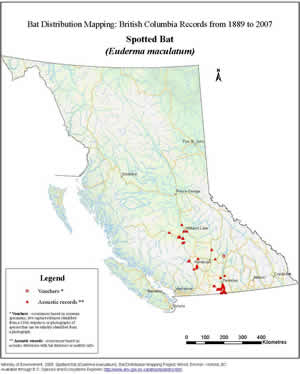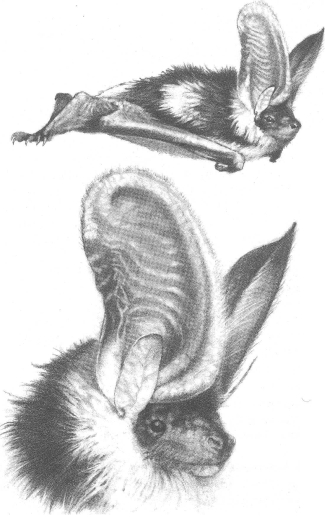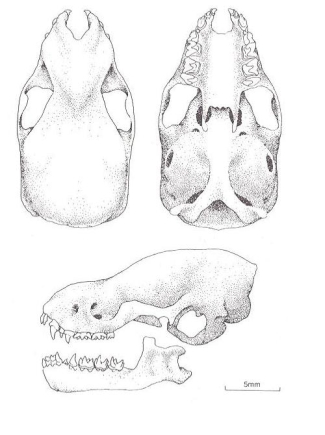Little information is available on reproduction but the scanty data suggest that mating takes place in autumn. Females produce one young; the only pregnancy record for British Columbia suggests that young are born in late June or early July.
|
The Spotted Bat hunts over open Ponderosa Pine forests, hay fields and marshes adjacent to lakes. Every summer it can be found foraging over the marshy area on the west side of Vaseux Lake. It leaves its roost 30 to 60 minutes after sunset. It is a solitary hunter that feeds on moths captured while flying 5 to 15 metres above the ground. Although large ears are often associated with gleaning bats, there is no evidence to suggest that the Spotted Bat is a gleaner. It is quite predictable in its daily movements, usually following a set route to its night-time feeding area and returning to the same roost night after night. It may move as far as 10 kilometres between the day roost and feeding areas.
Its echolocation calls range between 6 and 16 kilohertz, making this our only bat that can be heard without a bat detector, at least by those whose ears are relatively sensitive to high-frequency sounds. The calls resemble a high-pitched, metallic click and could be mistaken for insect sounds by those unfamilar with them. The calls of the Spotted Bat have several important characteristics that affect its natural history. Low-frequency calls should be most effective for detecting larger prey, which is consistent with the evidence suggesting that most of this bat's diet consists of medium-sized moths. Several researchers have suggested that the low-frequency calls enable the Spotted Bat to avoid detection by certain species of moths that can detect the ultrasonic echolocation calls of other bats. Another characteristic of low-frequency sounds is that they can carry for considerable distances through the air - it is suspected that the Spotted Bat can detect its insect prey at long range. The extraordinarily large ears probably help the bat hear the returning echoes of its low-frequency calls.
|
Typically, day roosts are in crevices of steep cliff faces. The most important roosting sites in the Okanagan Valley are located in cliffs at McIntyre Bluff, Gallagher Bluff, Spotted Bluff, the west side of Vaseux Lake and the Vaseux canyon.
The audible echolocation calls make it relatively easy for the biologist or naturalist to monitor the presence and activity of this bat. Even so, the distribution of Spotted Bats in the province is poorly known. The recent discovery of this species in the Thompson, Fraser and Chilcotin valleys indicates that there may be localized populations throughout the dry interior. We strongly encourage local naturalists in this region to familarize themselves with the sounds of this bat and to search for it in their area.
The Spotted Bat has been heard in the Okanagan from early April to late October, but the whereabouts of this population in winter is a mystery. Little is known about the winter biology of this bat throughout its entire range. The only hibernation record for its entire range is of four individuals in a cave in Utah some sixty years ago. Research in southern Utah suggests that this species is occasionally active during mid winter in the western United States. No hibernating individuals have been found in British Columbia. The Spotted Bat may hibernate in crevices in cliffs inaccessible to humans, or it may spend winter outside the province.
|
|


